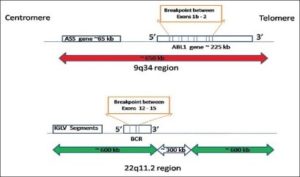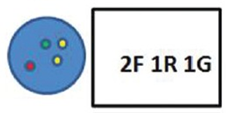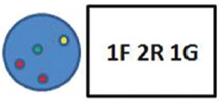Introduction
The reciprocal t(9;22)(q34;q11.2) is diagnostic of chronic myeloid leukemia (CML) and juxtaposes the ABL1 gene on chromosome 9 to the BCR locus on chromosome 22 resulting in the formation of a BCR::ABL1 fusion gene which has constitutive tyrosine kinase activity. It is also seen in acute lymphoblastic leukemia, although the molecular breakpoint on chromosome 22 is different in the majority of patients. Conventional cytogenetic analysis (karyotyping) of bone marrow is the most commonly used method for confirming the presence of the t(9;22). However, this requires familiarity with chromosome morphology and cell culture techniques and is labour-intensive. Therefore, fluorescence in situ hybridization (FISH) using a commercially available locus specific dual colour, dual fusion probe may also be used for confirmation of the t(9;22). In individuals lacking the t(9;22), two green and two red signals are seen on the normal chromosomes 9 and 22. This pattern is altered when the t(9;22) is present. FISH analysis at presentation can confirm that the t(9;22) is present and show whether the signal patterns are typical or atypical. The latter usually represent deletions on the derivative (translocated) chromosome 9, three-or four-way variant t(9;22) or an additional Philadelphia chromosome. Response to therapy can then be monitored by serial testing. A change in signal pattern, especially gain of the derivative chromosome 22 (Philadelphia chromosome) signifies that there is disease progression.
Probe used: Locus specific dual colour, dual fusion BCR::ABL1 probe

Description of FISH Signal Patterns:
Normal pattern:

nuc ish(ABL1,BCR)x2
The normal signal pattern consists of two red and two green signals (2R 2G) on the normal chromosomes 9 and 22 respectively.
Typical pattern:

nuc ish(ABL1,BCR)x3(ABL1 con BCRx2)
The typical BCR::ABL1 fusion pattern (2F 1R 1G) consists of two fusions (2F), one red (1R) and one green (1G) signal. The fusion signals are seen on the chromosomes 9 and 22 derived from the balanced t(9;22) while the red and the green signals are seen on the non-rearranged chromosomes 9 and 22, respectively.
Atypical patterns:

nuc ish(ABL1x2,BCRx3)(ABL1 con BCRx1)
The 1F 1R 2G is seen when the deletion involves only the chromosome 9 sequences 5′ of the ABL1 breakpoint.

nuc ish(ABL1x3,BCRx2)(ABL1 con BCRx1)
1F 2R 1G represents a deletion involving only the chromosome 22 sequences 3′ of the BCR breakpoint

nuc ish(ABL1,BCR)x2(ABL1 con BCRx1)
1F 1R 1G signal pattern is seen when the deletion involves chromosome 9 sequences, 5’of the ABL1 breakpoint as well as chromosome 22 sequences, 3′ of the BCR breakpoint

nuc ish(ABL1,BCR)x4(ABL1 con BCRx3)
3F 1R 1G represents gain of an additional Philadelphia chromosome.

nuc ish(ABL1,BCR)x3(ABL1 con BCRx1)
1F 2R 2G which usually represents either a three-way or a four-way variant t(9;22).
References:
- Primo, D., Tabernero, M., Rasillo, A. et al.Patterns of BCR/ABLgene rearrangements by interphase fluorescence in situ hybridization (FISH) in BCR/ABL+ leukemias: incidence and underlying genetic abnormalities. Leukemia 17, 1124–1129 (2003). https://doi.org/10.1038/sj.leu.2402963
- Srivastava, V., Jain, P., Parihar, M., Ahmed, R., Abraham, A., & George, B. et al. (2012). Fluorescence in situ hybridization patterns of BCR/ABL1 fusion in chronic myelogenous leukemia at diagnosis. Indian Journal of Pathology And Microbiology, 55(3), 347.
doi: 10.4103/0377-4929.101742 - McGowan-Jordan J, Hastings R, Moore S. ISCN 2020.
